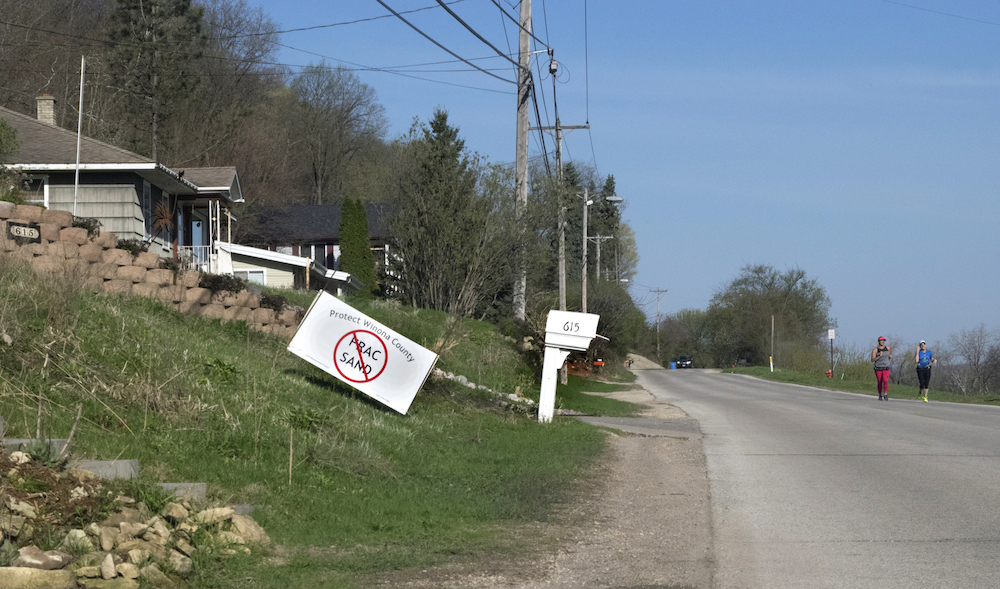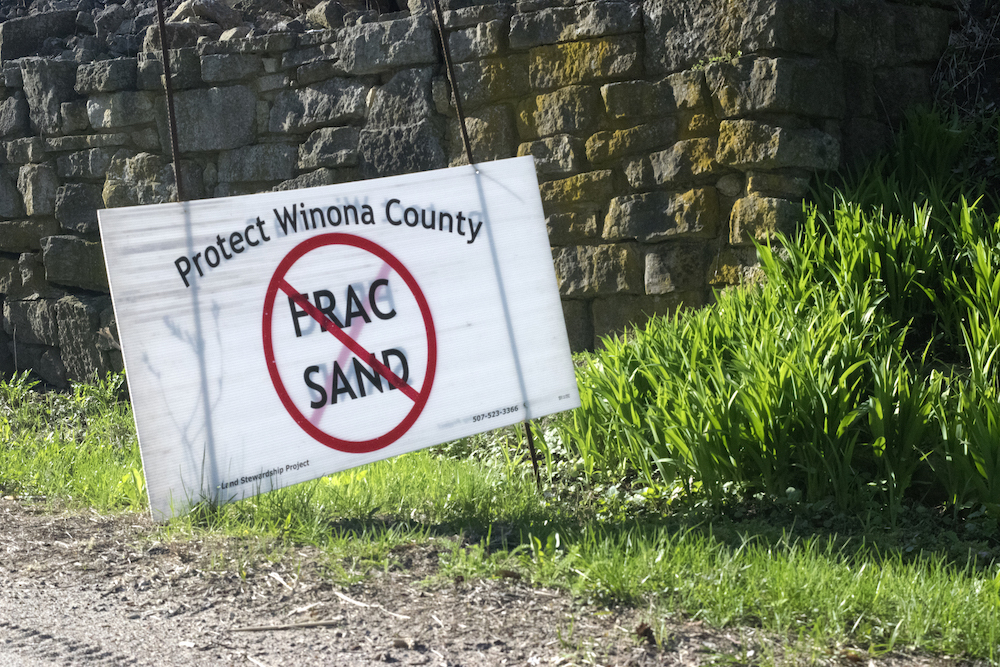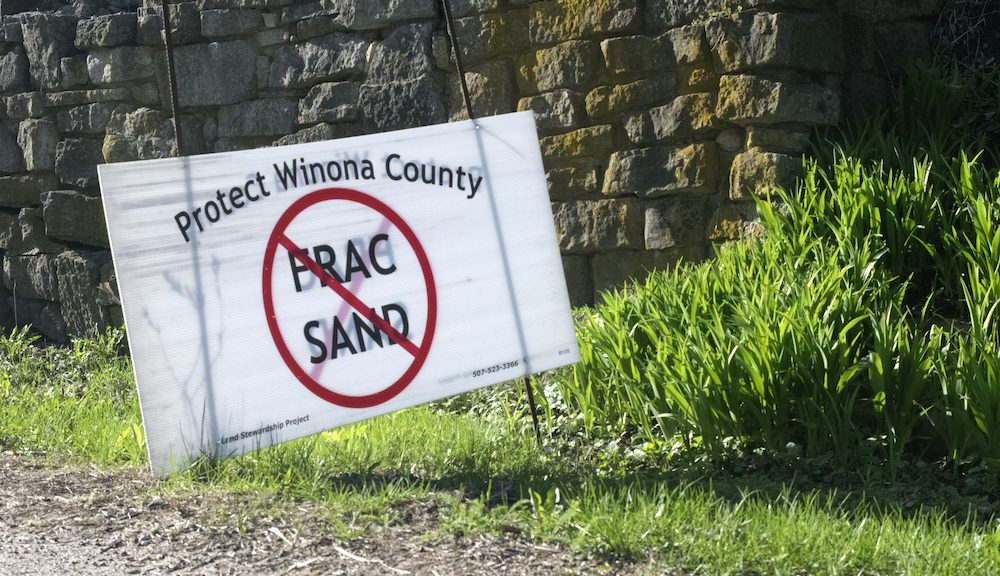“We love the beauty of this area, a lot of things about it,” Jim Gurley, a Winona County anti-frac sand mining activist, said. “I couldn’t sit back and let it be ruined.”
By Samantha Stetzer
In the bluffs that surround and cut through Winona County, some of the most useful silica sand can be found, according to Johanna Rupprecht, policy program organizer with the Land Stewardship Project.
The sand is at the center of an on-going conflict between mining companies looking to utilize the perfect form of the sand for hydraulic fracking and the activists trying to preserve it and keep it in the ground.
Miners target the driftless area, of which Winona County is part, for sand crystals ice glaciers left behind as they split around southwestern Wisconsin, southeastern Minnesota and northwestern Iowa during the Ice Age.
With a push from local activism and the Land Stewardship Project, a non-profit supporting agriculture and farmland, Winona County commissioners passed a frac sand mining ban on all county land after debate and action by community members for and against the mining by a vote of 3-2 in November 2016.

The ordinance only protects county land, which means local governments in Winona County can still approve the mines on city or town land, according to anti-frac sand mining activist Jim Gurley. If commissioners of a city or town in Winona County agreed to install a frac sand mine, they can still annex county land with a “ball-and-string” annexation, where towns and cities annex a small strip of land out to a “ball” of land, the main point of annexation.
Gurley added Minnesota’s government system also gives local governments more say over county and state governments on what happens on its land.
Following the ban, two lawsuits have been filed against Winona County claiming infringement on the rights of people and business owners to own and use the land as owners see fit, much to the expectation of the project, Rupprecht said.
Two parties, Richard Dablestein, owner of land in Winona County, and the Southeastern Property Owners of Minnesota organization, filed a lawsuit in March 2017. The lawsuit claims the ban violates the Minnesota and U.S. Constitutions and inhibits their ability to work on valuable land.
According to Rupprecht, the attorney’s office representing the plaintiffs in the first case, Larkin Hoffman, is commonly pro-frac sand mining and sent a lawyer to speak against the ban when it was being discussed.
A second suit was filed nearly a month later on Tuesday, April 18, by Minnesota Sands and claims nearly the same infringement on rights as the first suit. Minnesota Sands was founded in 2012 by Richard Frick and the company claimed on its website to have 10 leases for mining sites.
According to Rupprecht, Frick and his company were in the mining movement years before the ban was put in motion.
All mines, Rupprecht said, are required to produce an environmental impact statement about the impacts of their business on the land. The statement can cost millions of dollars, and in February 2015 Minnesota Sands paid $130,450 to begin the statement.
Since then, the company had produced no money or intention of continuing the statement and was virtually unheard of until the ban was enacted, Rupprecht said.
The saga of frac sand mining in Winona County for Gurley began in 2011. According to Gurley, prior to him getting involved, local farmers were being approached by sand companies offering to take their sandy land from them, since it was harder to farm on the land.
Gurley said there were no necessary conversations happening around the community, and public knowledge of the companies reaching out to residents was slim.
After investigating and researching, Gurley said he and his wife, whose home was located near a proposed mine, decided to devote time to advocating against the mine. He and fellow activists created Citizens Against Silica Mining in response.
“We love the beauty of this area, a lot of things about it,” Gurley said. “I couldn’t sit back and let it be ruined.”
While Gurley and other activists continued to fight, members with the Land Stewardship Project were asking for a ban to be placed, Rupprecht said. Gurley said two years ago he stepped out of his lead role anti-frac sand mining activism because the Land Stewardship Project had become more involved.

The project worked closely with Chicago-based attorney Ed Walsh, from the advice of anti-frac sand mining activist Joe Morse, to draft a version of the ban to present to the county.
Walsh, who has experience representing municipalities, said he primarily offered advice to the project for how to go about making the most constitutionally friendly ban possible, but he said the best piece of advice he thinks he gave was not legal.
“It was advice of making sure they felt they had county board members that were understanding and perhaps and philosophically in agreement with the concept of a ban on frac sand mining,” Walsh said.
According to Walsh, he advised the planning commission and the county board. He also reviewed the final wording and process by Winona County Attorney Karin Sonneman.
In Walsh’s legal opinion, the ban is constitutionally sound and the process that led to it was legal as well.
“I believe the ordinance will withstand the legal attacks in the court,” Walsh said.
Despite the recent court filings, Morse and Gurley said when the ban was enacted, they were thrilled to see their activism coming to a conclusion point.
Morse, who has been a self-proclaimed environmental activist for 30 years, said he does not believe cities and towns in Winona will allow more frac sand mines in their limits because of commitments made by the local governments and lack of space within city and town limits.
Having the ban laid out in a court setting could be beneficial, Morse added, because it could either give the ban firm legal permission to continue or it will allow the county to re-visit the issue as soon as possible, if it is found unconstitutional. With elections and turnover on the county commission, Morse said the court decision could be crucial for the movement.
Regardless of the outcome, Rupprecht said she believes the ban sends a strong message to a currently stagnant frac sand mining industry.
“It’s disappointing that the industry would be that desperate,” Rupprecht said about the lawsuit. “You don’t have a right to destroy the land.”
Attempts to talk with Minnesota Sands, Dablestein, the Southeastern Property Owners of Minnesota and lawyers for the first lawsuit were never returned.
Re-cap the frac sand mining ban here.
